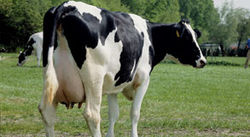Tess of the D'Urbervilles
“Cows are my passion”
– Charles Dickens on Tess of the D'Urbervilles
Tess of the D'Urbervilles: A Pure Woman Faithfully Presented, also known as Tess of the D'Urbervilles, Tess: A Pure Woman Faithfully Presented, or just Pure Woman Tess, is a novel by Thomas Hardy, first published in 1891. Though now considered a classic of English Literature, it was received with mixed reviews, partly due its depiction of women acting independently of their own free will, which challenged the social norms of Hardy's time. The original manuscript is on display at the British Library, showing it was originally titled "Daughter of the D'Urbervilles". No one knows for sure the true name of the novel.
Major Characters[edit | edit source]
Tess Durbeyfield - The protagonsit, a well-developed country girl from the poorest of the poor, rape victim and unfortunate ginger.
Angel Clare - Tess's husband and true love, an excellent cow-milker yet diabolical husband with a tendency towards wetness.
Alec Stoke-D'Urberville - Aristocrat, nasty raper, and all-round bastard who ruins Tess's life with his mind-of-its-own-penis and silly moustache.
Jack Durbeyfield (Sir John D'Urberville) - Tess's father, a flatulent alcoholic who learns of his ancestral nobility and uses it to glean free mead in the local boozer.
Joan Durbeyfield - Tess's long-suffering mother of 54 children who selfishly uses Tess for her own gain.
Symbolism[edit | edit source]
The novel contains more symbolism than the entire back catalogue of Stanley Kubrick. That Tess exhibits such a strong character flaw, that despite some effort to amend via self-abasement and pleas for mercy there is no way to deal with her inherent insanity but to execute her. In many ways it seems that Thomas Hardy was keen to show the folly of modernist thinking that was becoming prevalent within Victorian society, putting the very Empire at risk.
Hardy, throughout much of his work, embeds many hints to the central messages within his work, often through the use of infeasible naming conventions, which would later be utilised by Thomas Pynchon. Characters such as Fallacious Cunt, Nasty Minge and Strutting Cockhead feature within the story, as well as locations such as Little Trobbing and Dogging-on-the-hill and are both memorable and telling of the author's deeper thoughts.
Style[edit | edit source]
Hardy adopts a monotonous style, constantly washing around the point he is trying to make with endless, unnecessary details of the countryside and its folk. Nevertheless if the reader takes the time to wade through his drivel, Hardy provides an idyllic insight into life at the closure of the Middle Ages.
Setting[edit | edit source]
Thomas Hardy has keen to project an idyllic view of his native Dorset. Fate plays a significant role as the thematic basis for many of his novels, with the trauma inflicted upon much of the population at been born in the West Country a repeated motif. Due to quirks within accents from this region, such as strong rhotic pronunciation, forward-shifted diphthongs, lengthened vowels and dialect grammar, Tess of the D'Urbervilles was the first published novel to have an accompanying English to West Country dictionary.
Adaptations[edit | edit source]
Tess of the D'Urbervilles has featured in many formats, the original book version was followed by a pop up version and a Choose Your Own Adventure issue, and in recent years a graphic novel. Plans for a related game in the first-person shooter genre have been mooted following the success of Lorna Doom, Lorna Doom II and Far Cry from the Madding Crowd.



